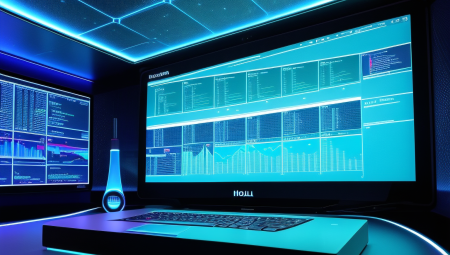In recent years, the landscape of education has been significantly reshaped by the integration of revolutionary educational technologies. From blending traditional and digital methods to utilizing artificial intelligence and virtual reality, these innovations are transforming the way students learn and educators teach. In this blog post, we will explore the various ways in which these advancements are impacting education, such as the rise of online courses and personalized learning tailored to individual needs. We will delve into the utilization of augmented and virtual reality in the classroom, and how gamification is turning education into an engaging and interactive experience. Additionally, we will discuss the importance of data-driven instruction and how collaborative and adaptive learning platforms are fostering teamwork and communication while adapting to each student’s pace. Join us on this journey as we explore the exciting developments in educational technology and their profound impact on the future of learning.
Table of Contents
Blending Learning: Combining Traditional and Digital Methods
Blending learning is an innovative approach to education that combines traditional methods with digital technology to create a more dynamic and effective learning experience. This method recognizes the value of both conventional teaching practices and modern digital tools, and seeks to leverage the benefits of both approaches to enhance the educational process.
By incorporating online resources, interactive digital platforms, and traditional face-to-face instruction, blending learning provides students with a more flexible and personalized learning experience. It allows students to access a wide range of educational materials and resources at their own pace, while also providing them with the opportunity to engage in collaborative activities and discussions with their peers and instructors.
In addition, blending learning enables teachers to tailor their instruction to the individual needs and learning styles of their students, ensuring that each student receives the support and guidance they need to succeed. This approach not only enhances student engagement and motivation but also helps to improve student outcomes and achievement levels.
Overall, blending learning represents the future of education, as it combines the best of both worlds to create a more effective and engaging learning experience for students.
The Rise of Online Courses: Easily Accessible Education
Online education has seen a significant rise in popularity in recent years, offering easily accessible opportunities for individuals to expand their knowledge and skills. With the advancement of technology, more and more educational institutions and organizations are offering online courses, making it convenient for learners to access quality education from the comfort of their own homes.
One of the key advantages of online courses is the flexibility they offer. Learners can access course materials and complete assignments at their own pace, allowing them to balance their studies with work, family, and other commitments. This flexibility is particularly beneficial for adult learners who may not have the time or resources to attend traditional in-person classes.
Furthermore, online courses often provide a wide range of subjects and disciplines, giving learners the opportunity to pursue their interests and career goals without being limited by geographic location or the availability of local educational institutions. This accessibility opens up new doors for individuals who may not have access to traditional educational resources.
As online education continues to grow, it is important to recognize the potential impact it can have on democratizing access to education. By breaking down barriers to learning, online courses are empowering individuals from diverse backgrounds to acquire knowledge and skills that can positively impact their personal and professional development.
Personalized Learning: Tailoring Education to Individual Needs
Personalized learning is a method of education that takes into account each student’s unique strengths, weaknesses, and learning styles. It involves the use of personalized learning plans that are tailored to individual needs, allowing students to progress at their own pace and focus on areas where they need the most help.
One of the key benefits of personalized learning is that it allows students to take more control of their own education. By having a say in what and how they learn, students are more engaged and motivated to succeed. This approach also helps to build self-confidence in students, as they are able to see their progress and success in real time.
Teachers also benefit from personalized learning because they are better able to identify and address the specific needs of each student. By using data-driven instruction and analytics, teachers can track student progress and intervene when necessary to ensure that all students are receiving the support they need to succeed.
In conclusion, personalized learning is an effective approach to education that allows students to receive the individualized support they need to thrive. By tailoring education to each student’s unique needs, personalized learning helps to create a more inclusive and effective learning environment for all.
Augmented Reality in the Classroom: Enhancing Learning Experiences
Augmented Reality (AR) is revolutionizing the way students learn and interact with the world around them. By blending digital information with the physical environment, AR technology is enhancing learning experiences in the classroom.
With AR, students can explore complex concepts in a more interactive and engaging way, making learning more fun and effective. For example, biology students can use AR to virtually dissect a frog, allowing them to see and interact with the inner workings of the amphibian without the need for a real specimen.
Furthermore, AR can bring history lessons to life by overlaying digital reconstructions of ancient civilizations onto real-world locations. This immersive experience allows students to visualize and interact with historical events, fostering a deeper understanding of the past.
In addition, AR makes it possible for students to take virtual field trips to distant places, such as the Great Wall of China or the Amazon rainforest, without leaving the classroom. This not only reduces the cost and logistical challenges of traditional field trips but also opens up a world of possibilities for students to explore and learn about different cultures and environments.
Gamification: Turning Education into an Engaging Game
Gamification in education refers to the incorporation of game elements and principles into learning environments to make the process more engaging and enjoyable for students. By integrating gamification into the education system, teachers can create a more interactive and immersive learning experience, which can significantly enhance student motivation and engagement.
One of the key benefits of gamification is that it can help students develop essential skills such as problem-solving, critical thinking, and teamwork in a fun and interactive way. By turning educational activities into games, students are more likely to be actively involved in the learning process, leading to a deeper understanding of the subject matter.
Furthermore, the use of gamification can also provide immediate feedback to students, allowing them to track their progress and make real-time adjustments to their learning strategies. This can lead to a more personalized and adaptive learning experience, as students can work at their own pace while still being challenged and motivated to succeed.
Overall, the incorporation of gamification into education has the potential to revolutionize traditional teaching methods and create a more dynamic and interactive learning environment that caters to the needs and preferences of today’s digital-native students.
Data-Driven Instruction: Using Analytics for Effective Teaching
One of the most exciting advancements in education in recent years has been the use of data-driven instruction to improve teaching and learning outcomes. By leveraging analytics and data tracking, educators have been able to gain valuable insights into student progress, engagement levels, and areas for improvement. This wealth of information enables teachers to make more informed decisions about their instructional strategies, ultimately leading to more effective teaching.
With data-driven instruction, educators can utilize analytics to identify at-risk students early on and provide them with additional support to prevent them from falling behind. By tracking student performance and behavior patterns, teachers can intervene proactively and tailor their approach to meet the specific needs of each student. This personalized approach to learning has been shown to have a significant impact on student achievement and motivation.
Furthermore, the use of data analytics allows educators to assess the effectiveness of different teaching methods and curriculum materials. By analyzing the impact of various instructional techniques on student outcomes, teachers can refine their practices and make evidence-based decisions about what works best for their students. This continuous cycle of assessment and adaptation contributes to a more dynamic and responsive classroom environment.
Overall, data-driven instruction holds great promise for transforming the educational experience for both teachers and students. By harnessing the power of analytics and using data to drive decision-making, educators can create more targeted, effective, and impactful learning experiences that meet the diverse needs of today’s learners.
Artificial Intelligence in Education: Intelligent Tutoring Systems
Artificial intelligence (AI) is revolutionizing the way education is delivered, and one of the most exciting applications of AI in education is the development of intelligent tutoring systems. These systems harness the power of AI to provide personalized learning experiences for students, offering tailored guidance and support based on individual needs and learning styles.
Intelligent tutoring systems use machine learning algorithms to analyze student performance data and adapt their instructional strategies in real time. This dynamic approach enables students to receive targeted assistance and feedback, helping them to overcome challenges and master new concepts at their own pace.
Furthermore, intelligent tutoring systems have the potential to significantly enhance student engagement and motivation. By leveraging AI to deliver interactive and responsive learning experiences, these systems can transform the classroom into a dynamic and proactive environment that fosters curiosity and a love for learning.
As technology continues to advance, so too will the capabilities of intelligent tutoring systems, paving the way for a future where every student can benefit from personalized, adaptive, and effective education.
Virtual Reality Field Trips: Bringing Places to the Classroom
In recent years, virtual reality has become increasingly prominent in the education sector, offering new and exciting opportunities for students to experience the world beyond the confines of the classroom. Virtual reality field trips, in particular, have revolutionized the way students learn, allowing them to explore far-off places without ever leaving their desks.
By utilizing virtual reality technology, teachers can take their students on immersive journeys to historical landmarks, natural wonders, and cultural sites, providing an unparalleled level of engagement and understanding. These virtual experiences offer a level of accessibility that traditional field trips simply cannot match, making it possible for students to visit locations they might never have the opportunity to see in person.
Furthermore, virtual reality field trips can be tailored to suit the specific needs and interests of individual students, allowing for a personalized learning experience that is not always achievable in a traditional classroom setting. This technology has the potential to bring the world to the students, breaking down geographical barriers and providing a more comprehensive and immersive educational experience.
As virtual reality continues to advance and become more accessible, the potential for using this technology to bring the outside world into the classroom is limitless. The integration of virtual reality field trips into the educational landscape represents an exciting shift in the way we think about learning, offering a new dimension of engagement and learning opportunities for students of all ages.
Collaborative Learning: Fostering Teamwork and Communication
Collaborative learning, a teaching method that involves students working together in groups to achieve a common goal, is an effective way to foster teamwork and communication skills. By collaborating with their peers, students learn to communicate effectively, listen to others’ perspectives, and work towards a shared objective. This approach not only enhances their academic performance but also prepares them for success in the real world, where teamwork and communication are essential skills.
One of the key benefits of collaborative learning is that it encourages active engagement among students. Rather than passively absorbing information, students are actively participating in the learning process, sharing their ideas, and debating different viewpoints. This active engagement fosters critical thinking, problem-solving, and decision-making skills, which are invaluable in their educational and professional development.
Furthermore, collaborative learning promotes a sense of community among students. They learn to respect each other’s opinions, appreciate diversity, and work towards a common goal. This sense of community creates a supportive and inclusive learning environment where students feel valued, understood, and motivated to succeed.
Lastly, collaborative learning prepares students for the demands of the modern workplace, where teamwork and collaboration are increasingly important. By developing their teamwork and communication skills in the classroom, students are better equipped to work effectively in diverse teams, contribute to group projects, and communicate their ideas with clarity and confidence.
Adaptive Learning Platforms: Adapting to Each Student’s Pace
Adaptive learning platforms have revolutionized the education system by providing personalized learning experiences for students. These platforms use artificial intelligence to analyze a student’s learning patterns and adapt the curriculum to match their pace. This allows each student to progress at their own speed, ensuring that they fully grasp the concepts before moving on to the next level.
By utilizing data-driven instruction and analytics, adaptive learning platforms can identify areas where a student may be struggling and provide targeted support to help them overcome these challenges. This individualized approach makes learning more effective and engaging for students, as they are not held back by the pace of the overall class, nor are they rushed through material that they have not fully comprehended.
Teachers also benefit from the use of adaptive learning platforms, as they are able to track the progress of each student in real-time and provide timely interventions when necessary. This level of personalized learning enables educators to focus on the specific needs of each student, ultimately improving the overall learning outcomes in the classroom.
Overall, adaptive learning platforms have the potential to revolutionize the education sector, making learning more accessible and effective for students of all backgrounds and abilities. By adapting to each student’s pace, these platforms ensure that no one is left behind, and every student has the opportunity to reach their full potential.





